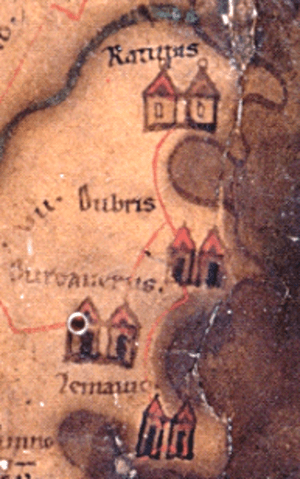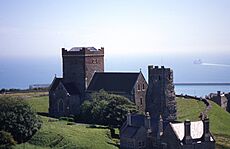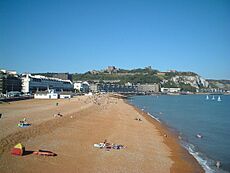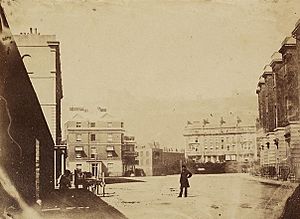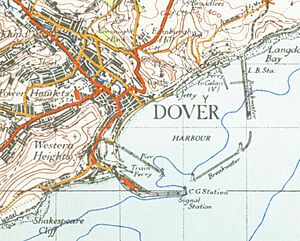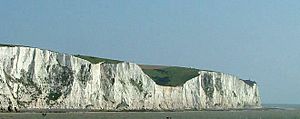History of Dover facts for kids
The History of Dover is super old and exciting! Because the town is so close to Europe, many different groups of people have come and gone over thousands of years. Long, long ago, during the Stone Age, people even walked across a land bridge to get here, before the English Channel was formed.
Over time, people built amazing defenses against invaders. They also made Dover a busy port for trade and travel. Today, Dover is still a major port for ferries and cruise ships. It's also a popular place for tourists who want to explore its many historical sites.
Contents
Early People in Dover
The very first signs of people living in the River Dour valley are from the Stone Age. Archaeologists have found old flint tools and pottery, especially in the Market Square. This area was a big settlement in Kent. These early settlers arrived by walking across a land bridge before the English Channel existed.
After the land bridge disappeared, new settlers had to come by sea. Their tools and items show that Dover was already a trading hub with Europe and Ireland. People from the Beaker culture lived here, and later, Bronze Age people traded in gold. A special gold find was made near Dover.
Two very important discoveries are now in the Dover Museum:
- A boat that is thousands of years old.
- A collection of axes found in Langdon Bay, near Dover.
A ring-ditch (a circular ditch from the Bronze Age) was also found nearby at Martin. Small items from the Iron Age have also been found.
Roman Dover and Beyond
From this time on, Dover's story is all about the sea. The Romans called Dover Portus Dubris. It was one of three important ports they used for trade and moving their army. The other two were Lympne and Richborough. All three ports connected to Watling Street at Canterbury. Over time, sand and silt built up, blocking the other two ports and even the mouth of the River Dour, Kent in Dover.
The Romans used Dover as a base for their navy, called the Classis Britannica. They built walls to protect against the sea and added two lighthouses on the hills on either side of the river's mouth. They might have also built a fort where Dover Castle stands today, to protect the port.
Dover became one of the three most important towns in Kent, along with Canterbury and Rochester. We know this because a very well-preserved Roman mansion was found here.
After the Romans left, the Jutes arrived. They helped create the Kingdom of Kent, which later led to Christianity coming to Kent. The story of Dover Castle might have even started during the Anglo-Saxon period. By the time the Viking Danish invaders came in 850, Dover was a main town. Dover Priory, a religious house, had been built in the early 600s.
Around 1050, five ports on Britain's south coast joined together to form the Cinque Ports. Dover was one of them. These ports had to provide ships and sailors for the king for 15 days each year.
Dover in the Middle Ages
Twenty years after the Norman conquest of England in 1066, the Domesday Book was created. This book listed everything in England. The entry for Dover was the very first one in the Kent section! It showed that Dover was worth £40. The town was now a borough, meaning its citizens ran their own guild and had a guildhall.
Soon after 1066, William the Conqueror chose a Governor for Dover Castle. This person was also given the important title of Lord Warden of the Cinque Ports.
This period saw many churches, hospitals, and other religious buildings being built. It seems a new castle was built near the old Saxon church of St Mary in Castro inside what is now Dover Castle. The church itself was repaired twice in the 1200s.
In Dover, the churches of St Mary the Virgin and St. James the Apostle were also built.
St Edmund's Chapel was opened in 1253 as a place for rest. The large Saxon church of St Martin le Grand had grown to include three other churches. However, it was closed during the English Reformation. A new Priory, also named St. Martin, was built on a different site. A college for priests was also started. Hospitals were built to help pilgrims. There were five hospitals in Dover, including Maison Dieu. Many of these old buildings still exist today, either as ruins or used for other purposes.
Much of Saxon Dover was rebuilt. By 1190, the new Dover Castle was finished. Sea trade grew, even though the port itself stayed small for a few centuries. In the 1200s, Dover faced two attacks. In 1216, Prince Louis of France tried to take Dover Castle and almost succeeded. In 1295, a French raiding party attacked the town and burned most of it down.
Dover from the 1500s to 1700s
During the time of the Tudor dynasty, there was still a threat of invasion from Europe. Under King Henry VIII, Dover's defenses were improved. The king even visited to check on the work at the castle and the Moat Bulwark. More improvements were made when Queen Elizabeth I was in charge.
The Dover Straits earthquake of 1580 was possibly the biggest earthquake ever recorded in England. It caused a lot of damage in Dover.
During the English Civil War (1642–1651), Dover first supported the king. However, it was captured by the Parliamentarians in 1648 without a long fight. King Charles II landed here in 1660 when the monarchy was restored. He asked Bernard de Gomme to make big repairs to the pier. On May 26, 1670, Charles II signed a secret treaty here, ending fighting with Louis XIV of France.
During the Napoleonic Wars, Dover became a heavily defended army town. This was because of the threat of French invasion. On a clear day, Napoleon's soldiers, gathered at Boulogne, could be seen from Dover.
First, earth forts were built along the seafront and across the Western Heights. These were added to the old medieval castle, which was no longer strong enough against new military weapons. Later, in 1804, a huge building project began. They built two modern forts, deep brick-lined ditches, and the Grand Shaft. This was a unique 140-foot (43 m) triple staircase that connected the town to the forts. It allowed soldiers from the barracks on the hill to quickly get to the seafront.
Dover in the 1800s
Between 1801 and 1901, Dover's population grew by 600 percent! The harbor was finally rebuilt with artificial walls. The town also tried to become a seaside resort. They built a pleasure pier, an ice rink, bathing machines, and impressive hotels and apartments along the seafront. The South Eastern Railway arrived in 1844, and cross-channel travel boomed. The town even had special "boat trains" and the famous Golden Arrow service.
Dover in the 1900s
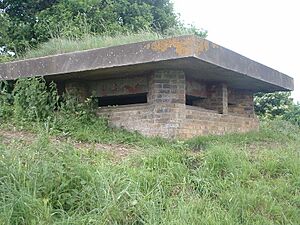
In the 1900s, Dover became the main center for defending the English Channel during World War I. It was the base for the Dover Patrol.
During World War I, Dover was one of the main ports for soldiers to leave for France. It was also bombed by airplanes and zeppelins. The first bomb dropped on England fell near Dover Castle on Christmas Eve 1914. Dover was also shelled by warships passing by. This forced people to hide in caves and dug-outs. The town became known as 'Fortress Dover' and was put under military rule.
In World War II, Dover faced constant bombing and shelling from guns across the Channel. There were 3,059 air raid alerts, 216 civilians were killed, and 10,056 buildings were damaged. A series of caves and tunnels in the cliffs were used as air-raid shelters and a military base. They even helped coordinate Operation Dynamo, which brought ships to Dover. Dover became a wartime symbol as part of East Kent's Hellfire Corner.
Defenses were built as part of preparations against invasion. These defenses included many pillboxes (small concrete forts), trenches, and minefields.
Dover's Industries
Dover used to have many industries, though most were small. The River Dour, which flowed faster in the past, provided power for mills, foundries, and breweries. Many of these businesses closed due to bigger companies taking over or simply because of more competition.
Some important industries in Dover included:
- A mustard factory in Biggin Street from the 1840s.
- A coffee and spice grinding factory on the same site.
- An oil mill in Limekin Street, which was one of Dover's biggest industries for many years. This building was even used as a center for troops returning home from Germany after World War I.
- An old candle factory near Market Street, believed to have been there since the time of Elizabeth I. For about 300 years, butchers in Dover had to take their meat fat to this factory to make candles!
- Edward Hills' coach building works, which started around 1827.
- The Dour Iron Foundry, started by A. L. Thomas. This company grew into Dover Engineering Works, then Elkington Gatic, and is now Gatic. They still make iron covers for drains and access points today.
One of Dover's oldest industries was making boots and shoes, especially for the military. Messrs Coulthard and Wilson had their factory in Last Lane. Buckland, near London Road, was known for its mills even when the Normans created the Domesday Book. These mills used the river's power to grind corn for bread, brew beer, and even make paper.
Some of these mill lands belonged to the Maison Dieu, but after King Henry VIII closed the monasteries, they went to private owners. By 1777, Ingram Horn, a paper maker, owned one of the larger mills. Later, Dover bankers Samuel Latham and Peter Fector also had financial interests in the mills at Buckland. The last big flour mill using the Dour waters was Chitty's Mill at Charlton Green. It was damaged by enemy action in World War II, caught fire, and never reopened. Today, houses and a Halfords store stand on that site.
See also
- List of people from Dover


